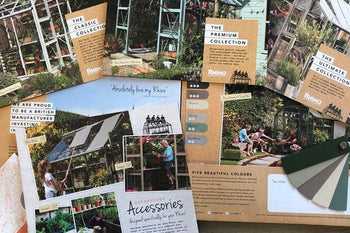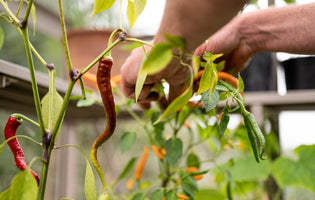If you’ve grown your own vegetables before, you know the glut problem. It starts in spring, as friendly allotment neighbors try to give you their spare tomato plants when 50 of your own seedlings are already rearing their heads in the greenhouse. Scrambling to harvest all the onions you planted months ago before they go bad. Trying desperately to make use of the 80 courgettes that have appeared all at once. We’ve all been there.
We conducted a survey to find out just how seriously gardeners in our Rhino family take the issue of waste, and 80% of those we asked were keen to reduce their garden waste further.1 Although only 21% felt that they were wasting too much and had many waste avoidance methods already being put into practice.2 So we're sharing their knowledge together with our own, to help you bring down your waste as much as possible.
Here are a few tips on how to dodge a glut, optimize your harvests and get more variety from your vegetable patch by only growing what you actually need and want.
Grow what you like
First things first - this sounds obvious but so many people grow vegetables that they don’t actually like. There’s no law that says you have to grow courgettes because they’re easy, or Chilies if you don’t like spicy food. If you know you are guilty of this, next time you spot a tray of kale seedlings for a £1 you must resist! Just because they’re cheap and easy to grow doesn’t mean it should be in your garden. That’s not to say you shouldn’t take risks and try new things – but there are better ways to use your valuable money and energy than on things you’ll end up throwing away.

Angela growing brassicas in a raised bed
Seedling swap
Give your spares to friends, co-workers and neighbors and, if you’re lucky, you’ll get other plants back in return. You could set up a plant swap party and enjoy some tea and cake with friends, while exchanging your 10 surplus kale plants for 10 entirely different fruit and veg seedlings. If you can’t give them away to friends, pop them by the roadside with a friendly sign and let strangers take them home. You’ll be surprised how quickly they disappear from your life and be comforted by the idea they are brightening someone else’s garden rather than sitting atop an already overflowing compost bin.
Limit the volume of plants
We’re all guilty of being heavy-handed with seed sowing in early spring, but you’ll only end up with more problems later. Overcrowded plants don’t grow as well; and nobody needs 15 squash plants fruiting simultaneously! You only really need one courgette plant, even for a family. Plant in great compost, give it plenty of space, and feed it well. If you like, train it up a squat and sturdy triangular frame to help support it. And hey presto! One happy healthy courgette plant to feed an entire household.
The same principle goes for tomatoes where you only need two or three, unless you’re happy to put your crop out by the roadside again. Restricting the volume means you have more space for many different vegetables too. Let’s leave it to the farmers to fill a field with one crop.
A rough guide on how many plants to grow in your garden or greenhouse (for a family of 4):
- Tomato plants – 2-5 (try using different varieties)
- Chili plants – 3-5
- Courgette plants - 1-2
- Potato plants - 3-4
- Kale plants -1-2
Successional planting
Successional sowing is a key strategy for avoiding a glut. By spacing out your sowing schedule, you will have enough to harvest each week without being overwhelmed by too much at once. Don't sow the whole packet of carrot or lettuce seeds in one go, instead sow a row every three or four weeks from late spring onwards.
Companion planting
Particular vegetable groups do really well when they’re grown in close proximity to each other. Choosing your combinations carefully means you can grow a greater variety in a small space without fear of crowding out. Think about those that fruit above or grow below the ground, what nutrients and soil types they prefer and how big they spread.
A few popular companionable veg combos to try out:
- Brassicas, legumes and onions is one great mix.
- Carrots like being with beans and tomatoes.
- Cucumbers thrive alongside corn and cabbages.
- Potatoes do well next to peas.
- Tomatoes are keen on celery and peppers.
This is speed dating for vegetables, and you’ll find plenty of inspiration and information online.
Mix it up with flowers and herbs. Check out companion flowers and herbs for the vegetables you are growing too. Surprising aesthetic displays as well as mutually beneficial growing benefits. Some flowers and herbs provide a natural form of insect repellent, while also making your plot even more productive. So try basil with tomatoes and marigolds with broad beans. Another great thing about broad beans is that on a warm evening, their flowers give off a delicious and subtle scent. Double the joy!
Crop Rotation
Keep your plants healthy by moving them every year, especially potatoes and tomatoes which take a lot out of the soil. Peas and beans, on the other hand, are good for returning nutrients to the soil. It is an important principle and allows your soil to recover. By swapping the plant groups, you ensure that the plants are not constantly using the same resources from the soil while other plants will actively give back nutrients.
You could do repeat planting, but chances are high of a disappointing crop, disease or a complete infestation, with nothing but lettuce as far as the eye can see!
Your crop rotation might go something like this:
Year 1: Legumes
Year 2: Brassicas
Year 3: Onions and other root vegetables
Year 4: Potatoes
You might find you can rotate your crops every few months. You can start early (particularly with the aid of a greenhouse) and get one crop of early potatoes or lettuces out by early summer and then fill that space with strawberry plants and herbs.
Grow in pots
A no fuss way to increase rotation and manage gluts is growing in containers. Growing in pots is an incredibly easy way to manage your quantities (because a pot is only so big!) and makes for easy moving as the seasons shift. Tomatoes, strawberries and potatoes grow really well in earthenware pots or even bags and can always be moved or sheltered if need be. Sweet peas in a big pot growing up a tall bamboo cane wigwam by your back door is always fun and easy. And if you’re prone to rearranging and playing with your aesthetics for fun Instagram posts, containers are your friend.

Herbs growing in pots outside Rhino Greenhouse
Image Credit: Matt Austin Images
Creative planning
In the darkest days of winter, many gardens look drab and empty, but with a bit of planning, you can have something to harvest and admire all year. And why not make your sowing schedule fun to make and look at too, as you’ll be referring to it constantly? Get pencil to paper and start sketching until you’re happy. If there are no pencils to be borrowed, pop into an art shop and buy yourself a set. You won’t regret it, partly because it’s fun and mainly because planning is the key to a wonderful vegetable patch. File it for next year’s reference as well, because even if you think you’ll remember what you had where, by the time it gets to January, chances are you won’t remember much.
Use Micro-climates and greenhouses to improve viability
Growing your plants in a more consistent and reliable environment will improve the likelihood that plants make it to maturity and fruit well into the summer. So if you are lucky enough to have a greenhouse or cold-frame, make use of it to give your plants the best chance. When you have these options available, you can grow fewer plants with greater certainty that you’ll get the desired results. No need to sow a hundred seedlings for fear of weather damage when you know the greenhouse will protect them all!
Cooking and preserving
Even with lots of careful planning, nature has a way of surprising us, so you may still end up with far more than you bargained for. But never fear – that’s why autumn is the season for preserving, and of course cooking is a year-round joy, so get creative! You can do 101 different courgette recipes including Nigella's delicious courgette cake, ratatouille, pasta sauce, fritters; not to mention the recipes you’ve yet to invent...

Gill Meller cooking with freshly picked courgettes and tomatoes from his Rhino Greenhouse
Image Credit: Matt Austin Images
You’ve still got a glut! Give to charity
Ask your local school if they fancy your spares or offer them to a charity hostel.
Compost It!
If all else fails, there is always your compost heap or wormery. With so many different composters available, you can be sure to find something that will work in even the smallest of gardens. With time, any composted material will provide fresh nutrition for the next generation of plants in your garden. Nothing need ever be wasted.

Annotations:
1. Instagram Survey (@rhinogreenhouses) Jan 11, 2021: "Do you want to reduce wastage in your garden?" 80% of 97 people surveyed answered "Yes".
2. Instagram Survey (@rhinogreenhouses) Jan 11, 2021: "Do you think you waste too much in your garden?" 21% of 94 people surveyed answered "Yes".
Updated - December 14, 2022
Published - January 19, 2021








